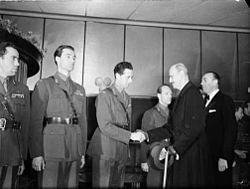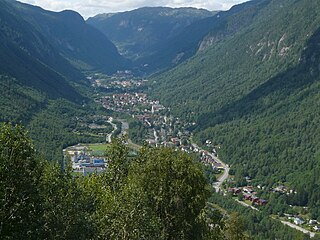
Knut Haukelid DSO MC (May 17, 1911 - March 8, 1994) was a Norwegian military officer. He was a Norwegian resistance movement soldier during World War II, most notable for participating in the Norwegian heavy water sabotage. [1] [2]

Knut Haukelid DSO MC (May 17, 1911 - March 8, 1994) was a Norwegian military officer. He was a Norwegian resistance movement soldier during World War II, most notable for participating in the Norwegian heavy water sabotage. [1] [2]

Knut Anders Haukelid was born in Brooklyn, New York. His parents were Bjørulf Knutson Haukelid (1878–1944) and Sigrid Johanne Christophersen (1877–1969), a couple from Norway who were living in Brooklyn at that time. His father was civil engineer working for the Interborough Rapid Transit Company, a now-defunct operator of part of the New York City Subway (1902–1912). Knut Haukelid was the twin brother of Norwegian American motion picture actress Sigrid Gurie (1911–1969). Since Haukelid and his twin sister were born in America, the twins held dual Norwegian-American citizenship. [3]
In 1914, the family returned to Norway. Haukelid subsequently grew up in Oslo, where his father worked as an engineer helping to lay out the Oslo Metro. In 1929, Haukelid came back to America to attend Massachusetts State College. He returned to Norway and later completed his education at the Dresden School of Technology and the University of Berlin (1937–38). Returning to Norway, he worked for his father's engineering firm, Haukelid og Five. [4]
Following the German occupation of Norway during World War II, he joined the Norwegian Independent Company 1 ( Kompani Linge ) in 1941. After extensive special training in Great Britain, he was selected as deputy commander of the Gunnerside group and sent back to Norway in 1943. Knut Haukelid and members of the Kompani Linge sabotaged the Nazi Germany-controlled heavy water Vemork plant in Rjukan in a long-range raid which began at an airfield in England. On February 28, 1943, the demolition team entered the Norsk Hydro plant and set explosive charges. The heavy water produced at a facility in occupied Norway was vital for the Third Reich's participation in the nuclear bomb race. The British War Cabinet subsequently ordered Haukelid to sink the Norwegian ferry SF Hydro as she transported containers of heavy water across Lake Tinn. The ferry was sunk with hidden explosives on February 20, 1944, killing 4 Germans and 14 Norwegian civilians. [5] [6]
For his participation in these raids, Knut Haukelid received multiple awards including Norway's highest decoration for military gallantry, the War Cross with sword. He was awarded this decoration twice, in 1944 and 1947: the War Cross with two swords. In addition, Haukelid was decorated by the British with the Distinguished Service Order and later with the Military Cross. [7]
Haukelid graduated from the Norwegian Military Academy in 1948. He served as major in the Telemark Infantry Regiment, and was later appointed head of the Home guard of Greater Oslo. Haukelid became a lieutenant colonel in the Army Infantry in 1959 and served as colonel and district commander of Greater Oslo Homeguard from 1966 until his retirement. He retired as a lieutenant colonel in 1974. [8]
In the spring of 1984, on the 40th anniversary of the sabotage action against the heavy water plant at Vemork, the survivors of the Kompani Linge group who participated in the action were honored at a reception at the residence Mark Evans Austad, American Ambassador in Oslo. [9]
On October 18, 1985, Knut Haukelid was honored at the Second Annual Scandinavian-American Hall of Fame Banquet in Minot, North Dakota. [10]
Knut Haukelid died at the age of 83 on March 8, 1994 at Det Norsk Diakonhjemmet in Oslo. He was buried at Vår Frelsers gravlund. [11]

Tinn is a municipality in Telemark county, Norway. It is located in the traditional districts of Aust-Telemark and Upper Telemark. The administrative centre of the municipality is the town of Rjukan. Some of the villages in Tinn include Atrå, Austbygde, Hovin, and Miland.

Rjukan is a town in Tinn Municipality in Telemark county, Norway. The town is also the administrative centre of Tinn Municipality. The town is located in the Vestfjorddalen valley, between the lakes Møsvatn and Tinnsjå. The municipal council of Tinn declared town status for Rjukan in 1996. The town is located about 10 kilometres (6.2 mi) to the west of the village of Miland and about 20 kilometres (12 mi) to the northwest of the village of Tuddal.

The Norwegian heavy water sabotage was a series of Allied-led efforts to halt German heavy water production via hydroelectric plants in Nazi Germany-occupied Norway during World War II, involving both Norwegian commandos and Allied bombing raids. During the war, the Allies sought to inhibit the German development of nuclear weapons with the removal of heavy water and the destruction of heavy-water production plants. The Norwegian heavy water sabotage was aimed at the 60 MW Vemork power station at the Rjukan waterfall in Telemark.

The Heroes of Telemark is a 1965 British war film directed by Anthony Mann based on the true story of the Norwegian heavy water sabotage during the Second World War from Skis Against the Atom, the memoirs of Norwegian resistance soldier Knut Haukelid. The film stars Kirk Douglas as Dr. Rolf Pedersen and Richard Harris as Knut Straud, along with Ulla Jacobsson as Anna Pederson. It was filmed on location in Norway.
Norwegian Independent Company 1 was a British Special Operations Executive (SOE) group formed in March 1941 originally for the purpose of performing commando raids during the occupation of Norway by Nazi Germany. Organized under the leadership of Captain Martin Linge, it soon became a pool of talent for a variety of special operations in Norway.

Vemork is a hydroelectric power plant outside the town of Rjukan in Tinn Municipality in Telemark county, Norway. The plant was built by Norsk Hydro and opened in 1911, its main purpose being to fix nitrogen for the production of fertilizer. At opening, it was the world's largest power plant with a capacity of 108 megawatts (145,000 hp).

Sigrid Gurie was a Norwegian-American actress from the late 1930s to early 1940s.

Joachim Holmboe Rønneberg was a Norwegian Army officer and broadcaster. He was known for his resistance work during World War II, most notably commanding Operation Gunnerside, and his post-war war information work.

Knut Magne Haugland, DSO, MM, was a resistance fighter and noted explorer from Norway, who accompanied Thor Heyerdahl on his famous 1947 Kon-Tiki expedition.

SF Hydro was a Norwegian steam powered railway ferry that operated in the first half of the 20th century on Lake Tinn in Telemark. It connected with the Rjukan Line and Tinnoset Line, at Mæl and Tinnoset, operating between 1914 and 1944. The combined track and ferry service was primarily used to transport raw materials and fertilizer from Norsk Hydro's factory at Rjukan to the port in Skien. It was the target of a Norwegian operation on 20 February 1944, when resistance fighters sank the ferry in the deepest part of Lake Tinn to prevent Nazi Germany from receiving heavy water.

Einar Skinnarland DCM was a Norwegian resistance fighter during the Second World War.

Kasper Idland MM, was a Norwegian resistance member during World War II. Idland took part in the Norwegian heavy water sabotage in 1943.

Jens-Anton Poulsson DSO, was a Norwegian military officer. During World War II he was a Norwegian resistance member, especially noted for his role in the heavy water sabotage 1942–1943. He continued his military career after the war, and was appointed colonel in 1968.
Arne Kjelstrup, MM was a Norwegian resistance member during World War II, especially noted for his role in the heavy water sabotage 1942–1943, and for being military leader of Milorg section D-161 (Kongsberg/Numedal) during the anti-demolition operation Sunshine 1944–1945.
Gunnar Bryde Syverstad, BEM was a Norwegian resistance member. He is known for his assistance in the Norwegian heavy water sabotage.

Operation Swallow: The Battle for Heavy Water is a Norwegian-French film from 1948. The history is based on the best known commando raid in Norway during World War II, where the resistance group Norwegian Independent Company 1 destroyed the heavy water plant at Vemork in Telemark in February 1943.
The Heavy Water War is a six-episode war drama TV miniseries written by Petter S. Rosenlund and produced by Norwegian Broadcasting Corporation. It is a Norwegian/Danish/British co-production directed by Per-Olav Sørensen based on the true story of the German nuclear weapon project during the Second World War and the heavy water sabotage in Norway to disrupt it, with a particular emphasis on the role of the Norwegian intelligence officer Leif Tronstad.
Birger Edvin Martin Strømsheim, was a Norwegian resistance member during World War II, especially noted for his role in the heavy water sabotage 1942–1943.
Titus Vibe-Müller was a Norwegian film director.
Hans "Kyllingen" Storhaug, MM, DSM was a Norwegian resistance member during World War II, especially noted for his role in the heavy water sabotage 1942–1943, and for his participation in the SOE operation Grebe and Grebe Red in Østerdalen 1943–1945.